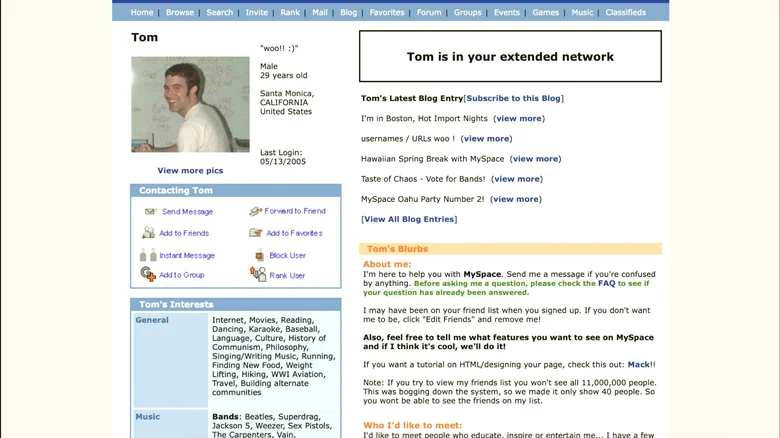In the ever-evolving world of social media, few platforms have experienced the meteoric rise and dramatic fall of Myspace. Launched in 2003, Myspace was the first global social network to capture the imagination of millions, revolutionizing how people connected online. At its peak in 2008, it boasted 115 million unique monthly users worldwide, making it the undisputed king of social media. However, the emergence of Facebook and other platforms eventually overshadowed Myspace, leading to its decline. Yet, despite its fall from grace, Myspace hasn’t disappeared—it has reinvented itself in a niche that keeps it alive today. Let’s take a deep dive into the history, evolution, and current state of Myspace.
The Birth of a Social Media Giant
Myspace wasn’t the first social network, but it was the first to achieve global dominance. Preceded by platforms like Friendster, Myspace took the best features of its predecessors and enhanced them, creating a unique space for users to connect, express themselves, and share content. What set Myspace apart was its emphasis on personalization. Users could customize their profiles using basic HTML, add their favorite songs, and even rank their friends—a feature that became a cultural phenomenon.
By 2005, Myspace had become the fifth most-visited website in the world. Its rapid growth caught the attention of media mogul Rupert Murdoch, whose company, News Corp., acquired Myspace for a staggering $580 million. At the time, it seemed like a smart investment, as Myspace continued to innovate and expand its user base.
The Rise of Facebook and Myspace’s Decline
While Myspace was thriving, a new competitor was quietly gaining traction. Facebook, launched in 2004, offered a cleaner, more streamlined user experience. Myspace’s leadership had the opportunity to acquire Facebook early on for $75 million but passed, a decision that would later be seen as a missed opportunity. By 2009, Facebook had surpassed Myspace in monthly active users, marking the beginning of Myspace’s decline.
Several factors contributed to Myspace’s downfall:
- User Experience: Facebook’s minimalist design and user-friendly interface appealed to a broader audience.
- Privacy Concerns: Myspace’s open and customizable profiles raised security issues, while Facebook offered more control over privacy settings.
- Shift in Focus: Myspace’s emphasis on music and entertainment alienated users seeking a more versatile social networking experience.
As users migrated to Facebook, Myspace struggled to retain its relevance. The platform underwent multiple ownership changes, each attempting to revive its fortunes.
Myspace’s Reinvention as a Music Platform

In 2011, Myspace was sold to Specific Media Group and pop icon Justin Timberlake for $35 million—a fraction of its previous valuation. Under Timberlake’s influence, Myspace shifted its focus from social networking to music discovery. The platform rebranded itself as a hub for artists and music lovers, allowing musicians to upload their tracks, share videos, and connect with fans.
This transformation marked a significant departure from Myspace’s original identity. While it no longer competed with Facebook or Instagram, it carved out a niche in the music industry. Today, Myspace operates as a music-centric platform, offering millions of tracks and videos from artists around the world.
Who Owns Myspace Now?
Myspace’s journey through various ownerships reflects its struggle to stay relevant:
- 2005: Acquired by News Corp. for $580 million.
- 2011: Sold to Specific Media Group and Justin Timberlake for $35 million.
- 2018: Acquired by Time Inc. as part of its purchase of Viant (formerly Specific Media).
- 2019: Sold to Viant Technology LLC, which currently operates the platform.
Despite these changes, Myspace has managed to maintain a small but dedicated user base. As of 2021, the platform attracts around 15 million users, a far cry from its heyday but a testament to its enduring appeal.
What Does Myspace Look Like Today?

Modern-day Myspace is unrecognizable compared to its original form. The platform is now entirely focused on music, with social media features taking a backseat. Users can explore a vast library of songs, discover new artists, and create playlists. Interestingly, Myspace allows users to sign in with their Facebook accounts to find friends—a nod to its past and a reminder of how the tables have turned.
While Myspace no longer dominates the social media landscape, it has found a unique identity as a music discovery platform. Its ability to adapt and reinvent itself is a testament to its resilience.
Lessons from Myspace’s Journey
Myspace’s rise and fall offer valuable lessons for the tech industry and social media enthusiasts:
- Innovation is Key: Myspace’s early success was driven by its innovative features, but its failure to keep up with evolving user preferences led to its decline.
- User Experience Matters: Facebook’s focus on simplicity and privacy resonated with users, highlighting the importance of a seamless experience.
- Adapt or Fade Away: Myspace’s transformation into a music platform demonstrates the importance of adapting to changing market dynamics.
The Legacy of Myspace
Myspace may no longer be the social media giant it once was, but its impact on the digital landscape is undeniable. It paved the way for modern social networks and introduced features that are now standard across platforms. While its reinvention as a music discovery site has kept it alive, Myspace’s legacy lies in its role as a pioneer of online connectivity.
For those who remember its golden era, Myspace remains a nostalgic reminder of the early days of social media. And for new users, it offers a unique space to explore music and connect with artists. Whether as a relic of the past or a niche platform, Myspace continues to hold a place in the ever-changing world of the internet.








